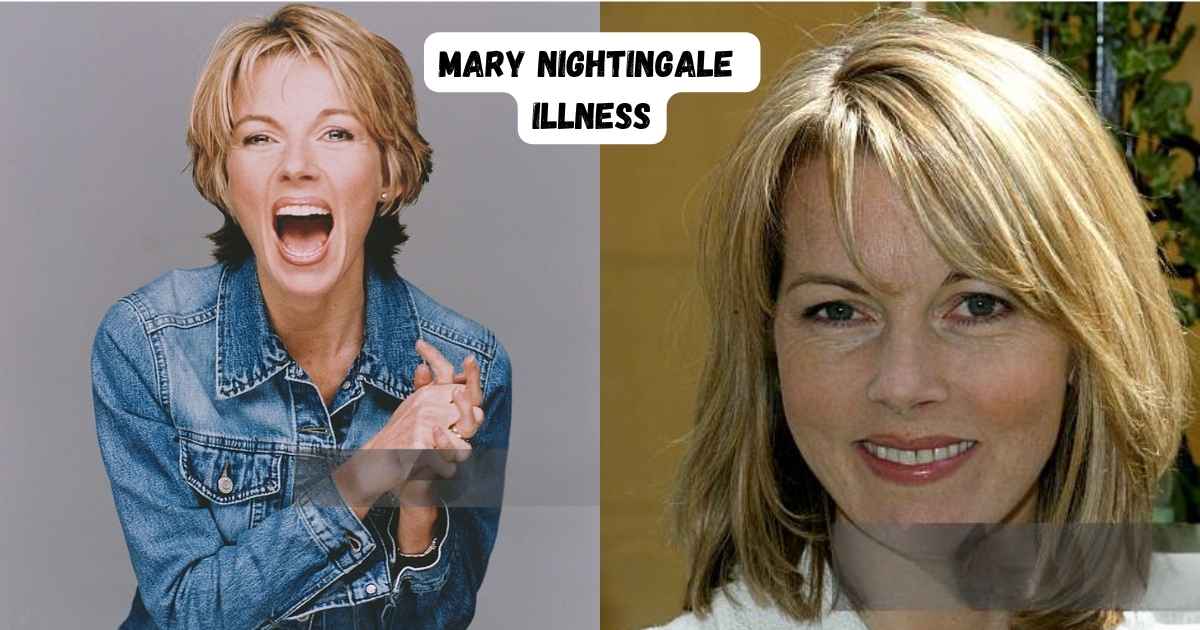For decades, Mary Nightingale graced British television screens with poise and professionalism. Millions trusted her calm delivery of evening news. Yet behind that composed exterior lurked struggles few suspected. The Mary Nightingale illness story reveals vulnerability in unexpected places. Her journey from silent suffering to public advocacy transformed perceptions about health challenges in broadcasting.
What happened to this beloved ITV Evening News anchor? Why did her voice—her most vital professional tool—betray her?
Mary Nightingale Overview
Born in 1963, Mary Nightingale became a household name across the United Kingdom. Her career spans over three decades in broadcast journalism. She joined ITV News in 2001, quickly becoming the face of evening programming. American audiences might compare her cultural impact to Diane Sawyer or Katie Couric.
Key Career Highlights:
- ITV Evening News lead anchor since 2001
- Multiple Royal Television Society awards
- Honorary doctorate from University of Westminster
- Over 30 years in broadcast journalism
- Trusted voice during national crises
Mary married Paul Fenwick in 2000. They share two sons, Sam and Joe. Beyond her professional achievements, she’s known for maintaining remarkable work-life balance—or so it seemed. The reality proved far more complex.
Her warm on-screen presence masked mounting pressure. The demands of nightly broadcasting take tremendous tolls. Few viewers understood the health challenges in journalism she quietly battled.
Mary Nightingale: A Pillar of British Journalism
Mary’s influence extends beyond simple news delivery. She represents a generation of female broadcasters who shattered glass ceilings. Her career began at BBC Radio, progressing through various regional stations before landing at ITV.
What sets her apart? Authenticity. While many anchors adopt persona for cameras, Mary remained genuine. Colleagues describe her as grounded, professional, and deeply compassionate. These qualities built extraordinary viewer trust.
Her broadcasting style balances gravitas with approachability. During national tragedies, her empathetic delivery comforted millions. She covered royal weddings, political upheavals, and devastating disasters with equal grace. The ITV presenter illness that would later emerge seemed impossible—she appeared invincible.
Industry recognition followed consistently. Royal Television Society honors. TRIC awards. Viewer polls repeatedly named her Britain’s most trusted news presenter. Yet accolades couldn’t protect her from what came next.
First Signs of Health Challenges
The Mary Nightingale health issues began subtly around 2015. Close observers noticed occasional voice strain during broadcasts. She’d clear her throat more frequently. Some days her delivery lacked usual fluidity.
Initially, she attributed symptoms to typical broadcaster occupational hazards. Voice strain affects many in the profession. Long hours, studio air conditioning, constant speaking—all contribute to vocal stress. She sought standard remedies: hydration, vocal rest, steam inhalation.
But symptoms persisted and intensified.
Early Warning Signs:
- Intermittent hoarseness
- Throat discomfort during lengthy broadcasts
- Increased vocal fatigue
- Difficulty projecting voice naturally
- Persistent throat clearing
The pressure of maintaining professional standards while managing symptoms became overwhelming. Broadcasting demands perfection. Viewers expect consistent delivery. Any vocal irregularity invites scrutiny and speculation. This created a vicious cycle: stress about symptoms worsening the symptoms themselves.
Medical consultations began. Specialists examined her vocal cords repeatedly. Initial diagnoses focused on physical causes. Was it nodules? Polyps? Something more serious? The uncertainty amplified her anxiety.
Mary Nightingale illness Dealing in Private
British culture traditionally values discretion about personal matters. Mary embodied this reserve. She chose to battle Mary Nightingale throat problems privately, sharing details only with immediate family and trusted colleagues.
Why the secrecy? Multiple factors influenced her decision:
Professional Concerns:
- Fear of being deemed “unreliable”
- Potential career implications
- Not wanting special treatment
- Maintaining viewer confidence
- Protecting her established reputation
Personal Reasons:
- Protecting family privacy
- Processing diagnosis privately first
- Cultural norms around vulnerability
- Uncertainty about prognosis
- Hope for quick resolution
Her husband Paul became her primary support system. He accompanied her to medical appointments. Together they researched treatments, sought second opinions, and managed the emotional toll. Their sons remained largely shielded from the severity.
The isolation of silent suffering weighed heavily. She couldn’t discuss struggles with colleagues. Social events became exhausting—maintaining cheerful facades while internally battling fear and discomfort. The stress-related illness components intensified as she compartmentalized her struggle.
Medical tests continued. Throat cancer scares emerged when specialists found abnormalities. Biopsies followed. The waiting period between tests and results proved agonizing. Each negative result brought relief, yet symptoms persisted unexplained.
The Public Revelation
In 2017, circumstances forced the Mary Nightingale illness into public awareness. During a particularly difficult broadcast week, her voice faltered noticeably. Social media erupted with concern. Speculation ran rampant—everything from serious disease to career-ending conditions.
ITV released a brief statement acknowledging Mary was “experiencing vocal difficulties” and receiving medical care. The vagueness fueled more speculation. Was it Mary Nightingale throat cancer? A neurological condition? Career exhaustion?
Mary herself eventually addressed the situation more directly. In a candid interview with Good Housekeeping magazine, she revealed the truth: her condition was primarily psychosomatic voice loss triggered by extreme stress and anxiety.
The medical term is functional dysphonia—where psychological factors cause genuine physical voice impairment without structural damage. Years of high-pressure broadcasting, combined with perfectionism and fear of failure, manifested in her losing the ability to speak normally.
“My voice just disappeared,” she explained. “Not from physical damage, but from carrying too much pressure for too long.”
The revelation shocked many. How could Britain’s calmest news anchor be suffering such severe anxiety? The disconnect between public perception and private reality couldn’t have been starker.
Strength in Vulnerability
Mary’s openness about the psychological nature of her Mary Nightingale medical condition proved revolutionary. In an industry that prizes apparent perfection, admitting mental health struggles felt risky. Yet her honesty created unexpected positive ripples.
Impact of Her Disclosure:
| Area | Effect |
| Public Perception | Humanized celebrity figures |
| Industry Standards | Normalized discussions about broadcaster wellness |
| Viewer Connection | Deepened trust and loyalty |
| Mental Health Awareness | Reduced stigma around psychological conditions |
| Professional Culture | Encouraged workplace mental health support |
Thousands contacted ITV sharing their own struggles with stress and anxiety. Teachers, doctors, lawyers, engineers—high-pressure professions across sectors related to her experience. Her courage to be vulnerable gave others permission to acknowledge their own struggles.
Colleagues privately thanked her. Many admitted battling similar issues silently. The broadcasting industry, she learned, harbored widespread mental health challenges hidden behind professional facades. Her disclosure sparked long-overdue conversations about journalist burnout and recovery.
“Being perfect isn’t human,” she reflected. “Being honest about imperfection connects us.”
The Role of Mental Health
Understanding the mental health and broadcasting connection became central to Mary’s recovery. Research shows journalists face elevated mental health risks compared to general populations.
Contributing Factors:
- Constant deadline pressure
- Exposure to traumatic content
- Public scrutiny and criticism
- Irregular work schedules
- Perfectionism expectations
- Limited emotional processing time
For Mary, decades of suppressing reactions to distressing news stories accumulated. She’d delivered reports on terrorism, natural disasters, child abuse cases—maintaining composed professionalism while internalizing trauma. The Mary Nightingale stress manifested physically when her mind and body could no longer compartmentalize.
She began intensive therapy combining cognitive behavioral techniques with voice therapy. The treatment addressed both psychological roots and physical symptoms. She learned:
- Stress management techniques
- Mindfulness and meditation practices
- Healthy boundary-setting
- Self-compassion rather than self-criticism
- Recognition of early warning signs
Voice therapy for broadcasters proved particularly valuable. Speech therapists helped her reconnect voice production with relaxed psychological states. She practiced speaking without the perfectionism that had created tension.
The journey wasn’t linear. Progress came in waves. Some days her voice returned fully. Others brought setbacks and frustration. She learned accepting imperfection was itself therapeutic.
Support from Fans and Colleagues
The outpouring of support following the Mary Nightingale health update demonstrated her profound impact on viewers. Social media flooded with messages of encouragement, personal stories, and expressions of continued trust.
ITV colleagues publicly praised her courage. Fellow presenter Alastair Stewart called her “the bravest person in broadcasting.” Journalist peers across networks expressed solidarity. The competitive industry united in support.
Notable Support:
- 50,000+ supportive social media messages
- Colleague tributes during broadcasts
- ITV’s flexible accommodation of recovery needs
- Viewer petitions expressing continued loyalty
- Industry awards recognizing her advocacy
Fan letters arrived daily at ITV. Many shared similar struggles with coping with career stress. Teachers wrote about classroom pressure. Healthcare workers described hospital stress. Parents discussed juggling impossible demands. Her honesty created community around shared vulnerability.
Paul Fenwick, her husband, became her public advocate. He emphasized the family’s pride in her courage. Their sons, initially concerned, expressed relief at understanding what their mother had been battling privately.
The Mary Nightingale support from fans extended beyond words. Viewers patient with her gradual return demonstrated loyalty transcending professional performance. They valued her humanity over flawless delivery.
Return to the Spotlight
Mary’s return to the ITV Evening News anchor desk happened gradually through 2018-2019. Initially, she shared presenting duties, reducing weekly workload. This phased approach allowed continued recovery while rebuilding confidence.
Her first full broadcast back felt momentous. Viewers noticed something different—not worse, but more authentic. She spoke with vulnerability alongside professionalism. The rigid perfectionism had softened into warm authenticity.
Recovery Milestones:
- 2017: Initial medical leave
- 2018: Gradual return with reduced schedule
- 2019: Full return to regular programming
- 2020: Expanded advocacy work alongside broadcasting
- 2025: Continued successful career with wellness priorities
The Mary Nightingale recovery process taught her valuable lessons about sustainability. She implemented strict boundaries: no work emails after 7 PM, regular therapy sessions, yoga practice, and protected family time. Broadcasting remained important, but no longer consumed her entire identity.
Colleagues noticed positive changes. She became more vocal about workplace wellness. She advocated for mental health resources at ITV. Her experience became catalyst for industry-wide policy improvements regarding broadcaster support systems.
Advocacy and Awareness
Leveraging her platform for Mary Nightingale awareness efforts became a defining second-act to her career. She partnered with Mind, the UK’s leading mental health charity, to promote workplace mental wellness.
Advocacy Initiatives:
- Annual fundraising campaigns for mental health charities
- Speaking engagements at journalism schools
- Documentary participation about broadcaster wellness
- Social media campaigns reducing stigma
- Policy consultation with broadcasting unions
Her efforts contributed to tangible industry changes. The National Union of Journalists developed comprehensive mental health support protocols. Broadcasting organizations implemented mandatory wellness training. Her advocacy helped countless colleagues access previously unavailable resources.
The British news anchor health conversation expanded beyond Mary’s personal story. Industry-wide discussions addressed systemic issues: unrealistic expectations, inadequate support systems, and cultural resistance to vulnerability. Real policy changes followed these conversations.
Mary’s message resonated particularly with young journalists entering the profession. She spoke frankly about the resilience under pressure required, while emphasizing that resilience includes seeking help, setting boundaries, and prioritizing wellness.
Mary Nightingale illness Conclusion
The Mary Nightingale illness journey transcends one person’s health struggle. It illuminates broader truths about pressure, perfectionism, and the price of suppressing vulnerability. Her story demonstrates that even society’s calmest, most composed figures battle internal struggles.
What did we learn from her experience?
Key Takeaways:
- Mental health affects everyone, regardless of success
- Perfectionism can become self-destructive
- Vulnerability strengthens rather than weakens us
- Support systems prove essential during crisis
- Advocacy transforms personal struggle into collective progress
Her ongoing career proves that disclosure doesn’t end professional success—it deepens authentic connection. The Mary Nightingale health journey continues, with daily wellness practices supporting sustainable performance. She still anchors ITV Evening News, now with self-compassion alongside professionalism.
For those facing similar health challenges in journalism or any high-pressure field, Mary’s story offers hope. Recovery is possible. Help is available. Perfection isn’t required. Human beings do their best work when acknowledging their full humanity—struggles included.
How is Mary Nightingale doing now? She thrives with balance she once thought impossible. Her health remains stable through continued therapy and boundary maintenance. More importantly, she’s helping reshape cultural conversations about mental wellness in demanding professions.
The shocking truth behind her health struggles? Sometimes the strongest people carry the heaviest invisible burdens. And sometimes, acknowledging those burdens becomes the greatest strength of all.

Welcome to Azaad Bites! I’m the creator and heart behind this site, a passionate foodie with a love for all things delicious. Cooking has been my creative outlet and joy for years, and I’m here to share my favorite recipes, cooking tips, and food discoveries with you. From comforting classics to bold new flavors, I believe that every dish tells a story, and I can’t wait to share mine with you. Whether you’re a seasoned chef or a kitchen newbie, I hope to inspire you to explore the world of food and drink with a dash of curiosity and a lot of flavor.

